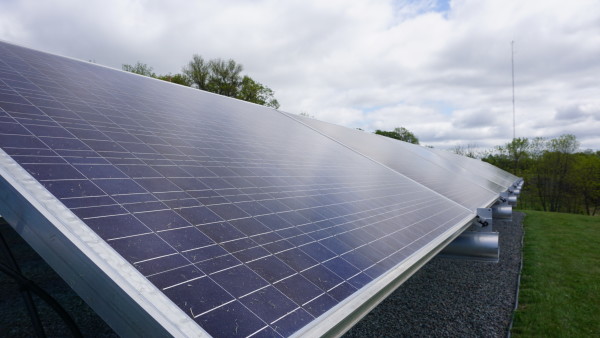The rapid growth of solar and other renewable energy sources has led consumers and policymakers in some U.S. communities to expect their electric utilities to soon achieve a “100 percent renewables portfolio” for energy supply. Attaining that goal, however, raises complex questions of cost and reliability.
With so much activity in the renewable energy market, it seems reasonable to assume a 100 percent renewable portfolio is achievable. But is that true? This study looked at the viability and challenges of achieving a 100 percent renewable portfolio using Vermont Electric Cooperative in Johnson, Vt., and Pedernales Electric Cooperative in Johnson City, Texas, as case studies. It explores the different definitions of 100 percent renewables and the costs and challenges of meeting this goal.
While it focuses primarily on the use of solar power, with and without energy storage, the fundamental results translate to any energy source that is not continuously available, such as solar, wind, wave/tidal, hydro, biomass, and geothermal. Some of these sources are steadier than others, but renewables by nature vary their output with natural conditions.
If any of the natural cycles of a renewable resource do not correspond with the needs of consumers, other means of energy generation, energy storage, or backup power must be supplied. The closer a community gets to 100 percent renewable generation, the more difficult and costly the access to other sources of energy become.
What Does '100 Percent' Mean?'
Municipalities across the country, and around the world, have announced their commitments to the goal of 100 percent renewable energy, spurring widespread consumer interest.
For many of those consumers, and the policymakers who respond to them, that commitment implies self-sustaining systems in which the community is powered solely from local or regional renewable sources. It suggests a mix of renewable sources that meet demand with power generated when the wind blows, the sun shines, water flows, and biomass is broken down.
In practice, however, most of those municipalities are actually talking about 100 percent
net-zero fossil energy use, where a community secures renewables generation equal to its total energy demand.
For example, if a community uses 1 million MWh a year, then it would procure 1 million MWh of renewable power through a mix of generation, renewable energy credits, and power contracts. The community would not be dependent on the renewable generators to power itself, since it would purchase both renewable and traditional fossil-fuel power as needed and sell excess power it doesn’t need.
 There’s a big difference between powering a community entirely from renewable sources and entirely offsetting fossil energy consumption by producing excess renewable power when resources are available. And despite the favorable public opinion, regulatory incentives, and self-imposed goals promoting and accelerating the adoption of renewable energy, no U.S. community appears to have yet achieved 100 percent self-sustaining renewable energy supply.
There’s a big difference between powering a community entirely from renewable sources and entirely offsetting fossil energy consumption by producing excess renewable power when resources are available. And despite the favorable public opinion, regulatory incentives, and self-imposed goals promoting and accelerating the adoption of renewable energy, no U.S. community appears to have yet achieved 100 percent self-sustaining renewable energy supply.
Achieving 100 percent net-zero fossil energy use is much more feasible, but that presents its own set of challenges. Net-zero schemes replace capacity and storage issues with accounting and energy equivalency problems.
Wide variations in electric demand, coupled with substantial swings in renewable supply capacity, complicate the equation even further. While fossil-fired generation output is relatively easy to predict and control, thanks to the near-continuous availability of a steady fuel supply, renewable generation is much less certain, or firm, and thus difficult to rely on for meeting firm electric demand.
This need for firm capacity in power delivery, dictated by the constant need to meet electric demand in full, has held back renewables integration for decades. The problem only gets worse when the proportion of renewables in the supply portfolio goes up.
Energy storage technology, usually in the form of batteries, could mitigate some of these concerns. Advancements in energy storage are being seen in the industry, but widespread availability and affordability in the marketplace is not yet evident. Even with advanced storage, fundamental power system operations questions must still be answered to ensure safety and reliability.
A Question of Contracts
Legal and contractual issues also arise when a distribution co-op sets out to secure 100 percent renewable energy.
Long-term power-supply arrangements are common practice throughout the utility industry, allowing distribution systems to secure more economical pricing and reliability. In the case of co-ops that are members of G&Ts, the distribution system’s power portfolio is largely shaped by the G&T, which in turn has long-term supply contracts with multiple distribution co-ops.
These power contracts often span decades. And because power-supply decisions at one member co-op potentially affect wholesale costs at other members of the G&T, an individual distribution co-op’s ability to alter its supply portfolio can be limited.
Limited Resources
Pedernales Electric Cooperative, which serves more than 250,000 meters just west of Austin, has seen increasing member interest in renewables, largely as a result of aggressive goals established in other Texas communities like San Antonio and Georgetown.
In response, the co-op is seeking to establish third-party supply agreements and is working with several members who have land suitable for solar arrays. The trouble is that it’s hard to match suitable sites to likely demand centers, says Peter Muhoro, the co-op’s director of energy and research strategies.
[image-caption title="A%20typical%20solar%20array%20at%20Wright%20Hennepin%20Electric%20Cooperative." description="(Photo%20courtesy%20Wright%20Hennepin)" image="/remagazine/articles/PublishingImages/WH-Both-solar-arrays-crop-600x189.jpg" /]
Land is scarce or expensive where demand is high, Muhoro says, and is readily available in places where demand is low.
“In the case of a very fast-growing area, where subdivisions are being developed every day, it is not uncommon for a developer to evaluate the benefits of including solar on the subdivision,” he says. “But in many cases, building another home on the land is more profitable than what they would earn from a solar system.”
Ready access to required equipment is another basic component that complicates matters. State and federal power portfolio mandates, along with associated tax incentives, are key drivers in expanding the renewable energy market. But with more and more utilities considering renewables, needed equipment may simply not be available in time to take advantage of the tax incentives.
Grid impacts and rules also play a part in these considerations. At Pedernales Electric, for example, any project of more than 1 MW must be registered with the Electric Reliability Council of Texas, and anything above 10 MW has to be listed as a qualifying facility and considered a generation resource. As a result, such projects are subject to costly and time-consuming grid-impact studies.
And the implications of increasing reliance on renewables continue to ripple out from there. Co-ops must consider their arrangements and pricing structures for renewable contracts, including net metering, interconnection processes and procedures, impact on staff and operations, and other effects.
“A lot of times in implementation, the market is not yet configured with the right protocols,” Muhoro says.
These challenges in balancing supply and demand are inevitable in an evolving market.
The $15 Billion Question
Engineers at
Vermont Electric Cooperative, a 34,000-meter utility that hits its peak demand of about 90 MW in the winter, undertook a detailed analysis to answer one question: What would it take to serve its members with centralized photovoltaic (PV) power and battery storage?
They launched their study with some basic assumptions:
- 100 percent renewable, in this case solar, meant just that. The co-op would buy no power from the regional market.
- To simplify the analysis, only a centralized PV array and battery storage was studied.
- Excess generation from that central PV station would be sold to the region’s Independent System Operator (ISO) at spot-market prices.
- Battery efficiency would be 80 percent, and battery storage levels would remain between 20 percent and 80 percent of maximum capacity.
- Battery costs would be $1 million per MWh, and the cost of solar power was $1.50 per installed watt.
- Solar’s capacity factor was 17.6 percent of alternating current supply capacity.
- Solar output was based on actual 2012 hourly data from a 2.2-MW generator.
After running the numbers, the co-op’s engineers concluded that a solar-and-battery system sufficient to meet all of its members’ needs around the clock would require nearly 3,600 MW of generating capacity and 10,000 MWh of storage, for a total installed cost of more than $15 billion.
Sales of excess power, the study found, could be expected to bring in $3 billion to $5 billion in net revenue over 10 years, depending on spot-market prices. Not included in that tally, however, is the cost of upgrading the transmission system to handle the exported power.
“While the impact to transmission could not be modeled, it is an important consideration as well,” says Vermont Electric CEO Christine Hallquist. “Currently our cost of transmission is $10 million per year, or roughly one-quarter of our power cost. Our current goal is to optimize our load factor, which would improve the efficiency of the grid. Moving toward lower generation capacity factors could move us away from that goal.”
The system the co-op’s study envisioned would produce between three and 19 times more energy in a given month than what the co-op’s consumers would actually need. The reason for such overbuilding is simple: The array and battery system must be sized to meet peak loads that coincide with limited resource availability.
As a winter-peaking utility, Vermont Electric’s highest demands would occur when nights are long, the solar resource is limited, and many days could pass with little ability to supply loads from the panels or recharge the batteries, all of which would effectively drain the system.
Even if solar PV and battery storage were to become as cost-competitive as traditional generation, the need to oversize such systems to meet worst-case demand scenarios is likely to make them more expensive, especially in northern regions.
What’s more, reliability concerns would be significant, considering the extent to which the supply portfolio relies on intermittent resource availability. Those concerns would intensify in cold-weather climates that can be particularly hard on battery operation.
For all of these reasons, the Vermont Electric study concluded that technical and economic realities require a better alternative than 100 percent solar and battery power supply. But the analysis also yielded other valuable results, such as findings the co-op can share with members interested in moving to 100 percent solar power; the ability to monitor trends in solar and be ready to take advantage of technological advances; and a clearer understanding of how the co-op’s load curves track with solar output.
Vermont Electric has also now established a goal of incentivizing installation of in-home storage systems, ranging from heat-pump water heaters to electric vehicles. Coupling these incentives with two-way member communications and innovative rate designs offers the co-op another opportunity to maximize its use of renewables.
Costs, Benefits, Complexities
Assuming that increasing the presence of renewable energy sources is a desirable goal, it appears that the most cost-effective approach will likely involve staged installations of renewable generation, often in the form of strategically sited generating systems that incorporate multiple generation and storage technologies.
Pedernales Electric in Texas has acknowledged this by revising its original goal of 30 percent renewable capacity by 2020. Now, Muhoro says, the co-op aims for “cost-beneficial solutions without member subsidy,” to equal or exceed state or national renewable portfolio averages (whichever is greater) by 2020.
“It is better to discuss and focus on a percent of increase in renewables, [rather] than 100 percent,” Muhoro says. “This needs to be taken one step at a time.”
In the face of increasing interest in renewable energy, he adds, educating co-op board members, staff, and consumers about these complex, wide-ranging questions and concerns becomes essential.
“It is important to communicate to the membership the costs, benefits, complexities, and challenges of integrating renewables,” Muhoro says.
Conclusions
As Vermont Electric’s study demonstrated, installing a single large, centralized renewable power plant to meet any utility’s total energy needs is probably not feasible, at least for now. A more logical solution involves gradual investments in renewable power where technical and economic barriers are relatively low, such as community “solar gardens.”
But this does not mean the idea of a future powered by renewables is dead, only that utilities must be careful and realistic when establishing goals and transitioning away from carbon-based fuels. The challenge remains how to effectively build a bridge between today’s energy resources and generating technologies and those of tomorrow.
Utilities should anticipate gradual improvements in the technical and economic feasibility of renewables generation and energy storage technologies over time and bring those resources into their portfolios when it makes sense to do so.
Co-ops must also educate their boards, staffs, and members so they have a clear understanding of the opportunities and challenges associated with renewable energy. In this way, co-ops can be responsive to members and support the evolving consumer-centric business model, all while making wise investment decisions for continued economic and reliable system operations.
